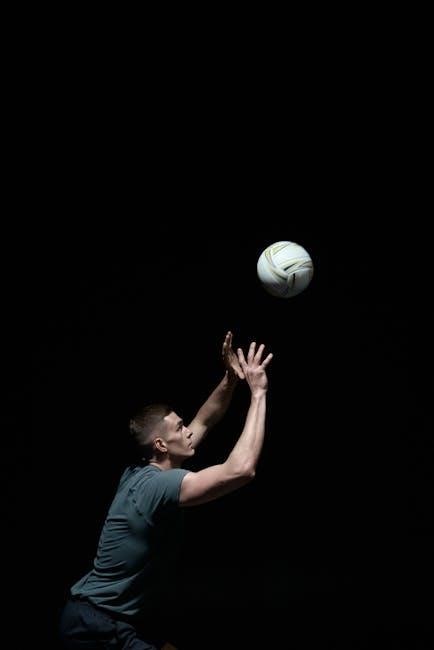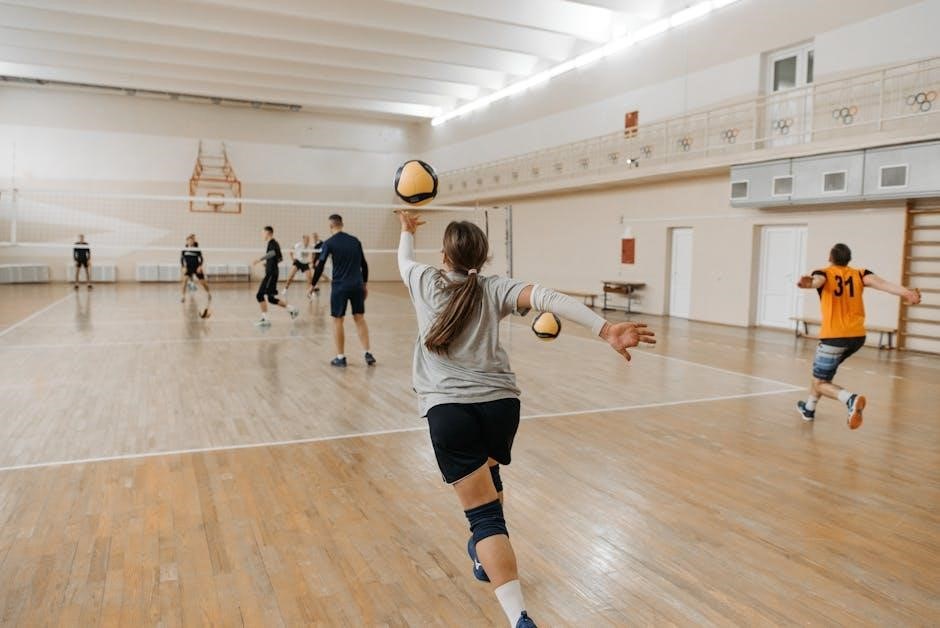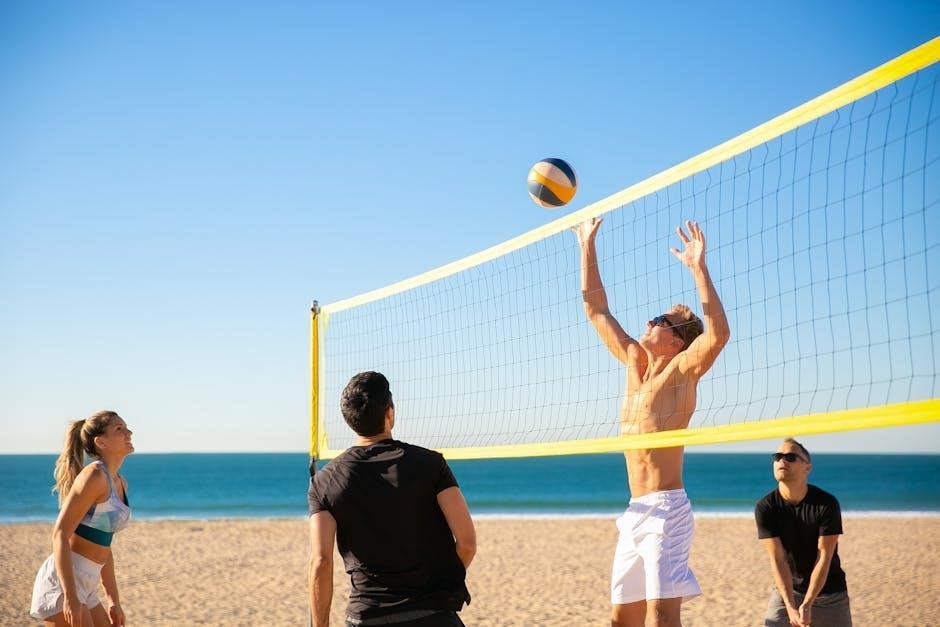The National Federation of State High School Associations (NFHS) oversees volleyball rules to ensure fair play and safety. The 2023 rules focus on player safety, sportsmanship, and consistency, providing a clear framework for high school competition.
1.1 Overview of the National Federation of High Schools (NFHS)
The National Federation of State High School Associations (NFHS) is the national leader in promoting and governing high school athletics and performing arts. With 51 member state associations, it serves over 19,500 high schools and more than 12 million students. Established to standardize rules and ensure fair play, the NFHS develops and publishes rules for various sports, including volleyball. Its mission is to provide education-based athletic programs that foster student growth through competition, sportsmanship, and teamwork. The NFHS ensures consistency and safety in high school sports nationwide, making it a cornerstone of interscholastic athletics in the U.S.
1.2 Importance of Rules in High School Volleyball
Rules in high school volleyball are essential for ensuring fair play, player safety, and maintaining the integrity of the game. They provide a standardized framework for competition, allowing players, coaches, and officials to operate within clear guidelines. By adhering to NFHS rules, schools promote sportsmanship, respect, and equal opportunities for all participants. Rules also help prevent injuries by regulating equipment, uniforms, and conduct. They ensure consistency across matches, enabling fair competition and proper enforcement of penalties. Ultimately, rules foster a positive and educational athletic experience, aligning with the NFHS mission to support student-athlete growth through structured, safe, and equitable sports programs.
Key Changes in the 2023 NFHS Volleyball Rules
The 2023 NFHS Volleyball Rules introduce significant updates, including expanded coaching zones, clarified jewelry regulations, and revised libero replacement procedures, enhancing gameplay consistency and player safety.
2.1 Expansion of the Coaching Zone
The coaching zone has been expanded, now defined by the libero replacement zone extending beyond the end line and sideline. This change provides coaches with a clearer area to instruct players during matches, enhancing communication and strategy. The expansion ensures consistency across all games, allowing coaches to move freely within designated boundaries while maintaining focus on player performance and teamwork. This adjustment aligns with modern coaching practices, promoting effective leadership and adherence to NFHS guidelines for fair play and sportsmanship.
2.2 Jewelry Rules: Small Secured Stud or Post Jewelry Above the Chin
The 2023 NFHS volleyball rules permit players to wear small, secured stud or post jewelry above the chin, aligning with current trends in other NFHS sports. This rule ensures consistency and fairness while maintaining player safety. Jewelry must be tightly secured to prevent injury risks during play. This update reflects a balanced approach between player expression and safety protocols, ensuring all athletes can compete without unnecessary restrictions while adhering to uniform standards for high school volleyball competitions.
2.3 Clarification on Libero Replacement and Substitutions
The 2023 NFHS volleyball rules clarify libero replacement and substitution procedures to enhance game flow and fairness. The libero may only be replaced by the player who was replaced at the start of the set. Substitutions must follow proper signaling protocols, and improper substitutions may result in penalties. Coaches are required to submit accurate rosters and lineup changes to avoid delays or administrative penalties. These clarifications ensure consistency in substitutions and maintain the integrity of the game, providing clear guidelines for coaches, players, and officials to follow during high school volleyball competitions.
Coaching Zone Regulations
The coaching zone is defined by the libero replacement zone, extending beyond the end line and sideline. Coaches must remain within this area during play.
3.1 Definition of the Coaching Zone
The coaching zone is defined as the area extending beyond the end line and sideline of the libero replacement zone. Coaches are restricted to this space during matches, allowing them to communicate effectively with players. This clarification ensures consistency in coaching areas across all games, promoting fair play and reducing confusion. The zone’s boundaries are clearly marked, providing a visible guide for coaches to adhere to during competition. This rule aims to maintain order and focus on player performance while enabling strategic guidance from the sidelines.
3.2 Coaching Zone Privileges and Restrictions
Coaches within the designated coaching zone may provide verbal instructions to players during stoppages in play. However, they must remain seated except during timeouts or between sets. Coaches are restricted from standing outside the zone or engaging in unsportsmanlike behavior. The rules emphasize that coaches must avoid unnecessary communication with officials or opposing teams. Additionally, coaches are not permitted to use electronic devices for communication during the match. These guidelines ensure fair play and maintain focus on player performance, while allowing coaches to strategically guide their teams within the defined boundaries. Adherence to these rules is essential for maintaining a respectful and competitive environment.

Jewelry and Uniform Rules
Players may wear small, secured stud or post jewelry above the chin. Uniforms must adhere to size and placement rules for mascots and school names, ensuring consistency and fairness.
4.1 Permissible Jewelry: Small, Secured Stud or Post Jewelry
Under the 2023 NFHS volleyball rules, players are allowed to wear small, secured stud or post jewelry above the chin. This rule ensures consistency with trends in other NFHS sports while maintaining player safety. Jewelry must be tightly secured to prevent injury risks during play. The rule aligns with broader guidelines to accommodate modern preferences without compromising fair play or safety standards. Proper adherence ensures all players can compete comfortably and fairly.
4.2 Uniform Regulations: Mascot and School Name Placement
The 2023 NFHS volleyball rules specify that a single mascot and/or school name may be placed on the uniform sleeve, with dimensions not exceeding 4×4 inches or 3×5 inches. This ensures uniformity and professionalism. The rule prohibits excessive or unauthorized decorations to maintain a clean appearance. Proper placement and sizing are enforced to avoid distractions and ensure fair play. Teams must adhere to these guidelines to comply with NFHS standards, promoting a consistent and respectful environment for all participants.

Pre-Match Procedures
Teams must submit rosters and designate liberos before the match. Late submissions incur penalties. The pre-match conference ensures all rules are reviewed and understood by both teams.
5.1 Roster Submission Requirements
Coaches must submit accurate rosters to the first referee during the pre-match conference. Rosters must include player names, numbers, and positions. Late submissions may result in penalties, such as a loss of rally or administrative yellow card. Teams can make changes until two minutes before the match without penalty. If a player is missing from the roster, they can be added, but the team may start with a penalty. The second referee manages roster submissions and ensures compliance with rules to maintain fair play and organizational efficiency.
5.2 Late Roster Submissions and Penalties
Failure to submit a roster on time results in penalties. If a roster isn’t provided to the second referee by the pre-match deadline, an administrative yellow card is issued. Teams may add missing players to the roster, but this could result in a loss of rally. The second referee enforces these rules to ensure compliance and maintain fair play. Late submissions disrupt the match process, so penalties encourage timely and accurate roster management. This rule emphasizes organizational efficiency and adherence to pre-match protocols.
5.3 Libero Designation and Lineup Changes
The libero must be clearly designated on the lineup card before the match. If the libero listed does not match the player on the court, the lineup can be corrected without penalty. Any changes to the libero designation or lineup must be communicated to the referees. Failure to properly designate the libero or incorrect lineup submissions may result in penalties, such as a loss of rally. The referees ensure compliance with these rules to maintain fairness and transparency in the game. Proper designation and lineup accuracy are critical for smooth match operations and adherence to NFHS regulations.

Scoring and Timing Rules
Scoring follows the rally system with point caps. Each set has specific time-out limits and between-set intervals. Proper timing ensures smooth match progression and fair play.
6.1 Match Formats: Two-Out-of-Three or Three-Out-of-Five Sets
Matches are structured as two-out-of-three or three-out-of-five sets, ensuring competitive balance. Each set is played to 25 points with a two-point cap. This format maintains excitement and fairness, allowing teams to showcase skills across multiple sets. The two-out-of-three setup is common in regular matches, while three-out-of-five is often reserved for championships. Rally scoring is used, awarding a point to the winning team, regardless of serve. Time management is crucial, with standardized intervals between sets. This structure promotes strategic play and ensures a clear winner, adhering to NFHS guidelines for high school volleyball competition.
6.2 Rally Scoring System and Point Caps
The rally scoring system awards a point to the winning team, regardless of serve, ensuring continuous play. Each set is played to 25 points with a two-point cap to decide the winner if the score is tied at 24-24. This system emphasizes quick gameplay and strategic plays, maintaining excitement throughout the match. The two-point cap prevents prolonged sets, ensuring timely match conclusions while preserving competitive integrity. The NFHS rules maintain consistency across all high school volleyball competitions, promoting fair play and efficient match progression. This scoring format is widely adopted for its clarity and effectiveness in high school athletics.
6.3 Time-Out and Substitution Limits
Each team is allowed 18 substitutions per set, ensuring strategic player rotations. Time-outs are limited to two per set, each lasting 30 seconds, enabling brief breaks for tactical adjustments. Substitutions must be requested through hand signals, with referees monitoring compliance. The libero, a key defensive player, can only be replaced by the designated substitute, maintaining positional balance; These limits promote efficient gameplay and fair competition, adhering to NFHS rules for high school volleyball. Proper substitution protocols ensure smooth transitions, maintaining the flow of the match while allowing coaches to make impactful decisions within set boundaries. Rules are enforced to uphold fair play and sportsmanship.
Penalty Regulations
Administrative penalties, including yellow and red cards, enforce sportsmanship and rule adherence. Unsportsmanlike conduct results in penalties, with ejections for severe violations, ensuring fair play and accountability in NFHS volleyball.
7.1 Administrative Penalties: Yellow and Red Cards
Administrative penalties, such as yellow and red cards, are used to enforce rules and maintain sportsmanship. A yellow card serves as a warning for unsportsmanlike conduct, while a red card results in ejection. Coaches or players receiving a red card must leave the match and remain sidelined. Repeat offenses or severe misconduct escalate penalties, ensuring fair play and accountability. Officials issue these cards at their discretion, with procedures outlined in the NFHS rules to handle such incidents consistently and transparently, upholding the integrity of the game.
7.2 Conduct Cards: Unsportsmanlike Behavior and Consequences
Conduct cards are issued to address unsportsmanlike behavior, ensuring fair play and respect among players, coaches, and officials. A yellow card serves as a warning, while a red card results in ejection from the match. Coaches receiving a yellow card must remain seated, and a red card leads to ejection. Players or coaches with repeated offenses or severe misconduct face escalating penalties. Officials enforce these rules consistently, documenting incidents to maintain accountability and uphold sportsmanship standards throughout the game.
7.4 Ejection Procedures for Coaches and Players
Ejections are enforced for severe or repeated unsportsmanlike conduct. Officials issue a red card, leading to immediate removal from the match. Coaches must leave the vicinity and remain seated if only a yellow card is issued. Players ejected must be substituted and cannot return. The referee documents the incident, including the reason and the individual involved. These procedures ensure accountability and maintain a respectful environment. Consequences are clearly communicated to the team captain and coach, emphasizing fair play and adherence to NFHS rules.

Substitutions and Rotations
Substitutions in volleyball require clear signals and proper procedures. Players must enter through the substitution zone, and rotations must follow the correct order. These rules ensure fair play and maintain game flow.
8.1 Substitution Signals and Procedures
Substitutions must follow specific signals and procedures to maintain fairness. The second referee indicates a substitution with two short whistles and rotating open hands at shoulder height twice. Players must enter through the substitution zone, located at the center line, and the incoming player must wait until the outgoing player has left the court. Proper substitution signals ensure smooth transitions and prevent confusion. Failure to adhere to these procedures may result in penalties or delays. Coaches and players must be aware of these rules to avoid illegal substitutions and maintain the flow of the game.
8.2 Rotation Rules and Illegal Substitutions
Players must rotate in a clockwise manner and remain in their positions until the ball is served. Illegal substitutions occur when a player re-enters the game without following proper procedures or enters the court without permission. The second referee monitors substitutions and rotations, ensuring compliance. If a substitution is deemed illegal, a penalty is assessed, and the opposing team may gain a point or serve. Coaches must ensure players understand rotation rules to avoid penalties and maintain fair play throughout the match. Proper rotation and substitution practices are critical for a smooth and competitive game.
8.3 Libero Substitutions and Restrictions
The libero can only be replaced through a substitution or an exchange. A substitution occurs when the libero enters or exits the court between sets or during stoppages. An exchange happens during live play, requiring the libero to swap places with another player at the sideline. The libero must wear a contrasting jersey and cannot block, attack, or set the ball. Substitutions involving the libero are recorded and limited to the designated libero replacement zone. These rules ensure the libero’s role remains specialized and fair, maintaining the integrity of the game. Coaches must carefully manage libero substitutions to avoid penalties.
Libero Rules
The libero plays a unique defensive role, wearing a contrasting jersey. They cannot block, attack, or set the ball, adhering to specific replacement and substitution rules.
9.1 Libero Responsibilities and Restrictions
The libero’s primary role is defensive, with responsibilities including receiving serves and digging attacks. They must wear a contrasting jersey and remain within the backcourt. The libero cannot block, attack, or set the ball in front of or above the attack line. Substitutions involving the libero are restricted to specific procedures, ensuring fair play. The libero can only replace another backcourt player through designated rotations. These rules maintain the integrity and balance of the game, while emphasizing player safety and adherence to NFHS guidelines.
9.2 Libero Replacement Procedures
The libero can only be replaced by a player who was on the court at the end of the previous play. Substitutions must occur through the designated backcourt and follow proper hand signals. The second referee indicates substitutions with two short whistles and rotating hands. The libero must exit the court before their replacement enters. Any improper substitution results in a penalty, such as a loss of rally or position. These rules ensure fair play and maintain the integrity of the game, as outlined in the 2023 NFHS Volleyball Rules.
Injury Protocols
Injury timeouts allow for medical evaluation, with substitutions permitted for injured players. Concussion protocols require immediate removal and coach notification, ensuring player safety and proper assessment.
10.1 Concussion Protocols and Player Safety
The NFHS emphasizes concussion protocols to prioritize player safety. Officials are trained to recognize symptoms and immediately remove affected players from the game. Coaches and trainers must assess injuries promptly, ensuring athletes do not return to play without medical clearance. This rule ensures player well-being and aligns with current medical guidelines, preventing potential long-term health risks. The protocols underscore the importance of caution and proper evaluation in maintaining a safe athletic environment. By adhering to these guidelines, the NFHS promotes responsible injury management and supports athletes’ health. This approach reflects a commitment to safety in high school volleyball.
10.2 Injury Time-Outs and Substitutions
Injury time-outs allow for immediate attention to injured players, ensuring their safety. Play is stopped, and medical staff or coaches assess the situation. Each injury permits one substitution, with the injured player replaced by another. If the libero is injured, specific substitution rules apply to maintain positional integrity. Coaches must notify officials of substitutions, and injured players cannot return without medical clearance. This rule balances player safety with fair competition, ensuring injured athletes receive proper care while maintaining game continuity. The NFHS emphasizes the importance of prioritizing health in all decisions. This approach supports both athlete well-being and competitive integrity.

Sportsmanship and Conduct
Sportsmanship and conduct are essential in NFHS volleyball, emphasizing respect, fairness, and integrity. Expectations include proper behavior from coaches, players, and spectators to promote a positive environment.
11.1 Expectations for Coaches, Players, and Spectators
Sportsmanship and respect are cornerstone values in NFHS volleyball. Coaches must model positive behavior, instructing players in ethical conduct. Players are expected to exhibit respect toward opponents, officials, and teammates. Spectators should support teams positively without engaging in inappropriate behavior. Unsporting conduct, such as taunting or excessive protests, may result in penalties like yellow or red cards. Coaches and players must adhere to rules, while spectators are urged to promote a supportive and respectful atmosphere. These expectations ensure a fair and enjoyable experience for all participants and fans alike, fostering a culture of integrity and mutual respect. Open communication and accountability are key to maintaining these standards.
11.2 Handling Inappropriate Behavior by Non-Team Personnel
Inappropriate behavior by non-team personnel, such as spectators, is primarily managed by home management. This includes addressing unsportsmanlike conduct from fans or other individuals not directly involved in the game. Officials may request assistance from security or school administrators to ensure a safe and respectful environment. The primary goal is to prevent disruptions and maintain focus on the game. Open communication and prompt intervention are essential to resolve such issues efficiently. Home management bears the responsibility of ensuring that all individuals adhere to expected standards of behavior, fostering a positive atmosphere for players, coaches, and officials alike during the match.
The 2023 NFHS volleyball rules prioritize player safety, sportsmanship, and fair play, ensuring a consistent and enjoyable experience for all participants and spectators nationwide.
12.1 Summary of Key Rule Changes for 2023
The 2023 NFHS volleyball rules introduced notable updates to enhance game integrity and player safety. Key changes include the expansion of the coaching zone, allowing small secured jewelry above the chin, and clarifying libero substitutions. Additionally, concussion protocols were emphasized to protect player health. Uniform regulations were updated to specify mascot and school name placement. These adjustments aim to maintain consistency, fairness, and safety across high school volleyball competitions nationwide.
12.2 Importance of Adhering to NFHS Rules for Fair Play
Adhering to NFHS volleyball rules ensures fair play, respect, and safety for all participants. These rules create a standardized framework for competition, promoting equality and reducing conflicts. Coaches, players, and officials must uphold these guidelines to maintain the integrity of the game. Non-compliance can lead to penalties, ejections, or game disruptions, undermining the spirit of sportsmanship. By following NFHS rules, the volleyball community fosters a culture of respect and accountability, ensuring a positive experience for everyone involved in high school athletics.
